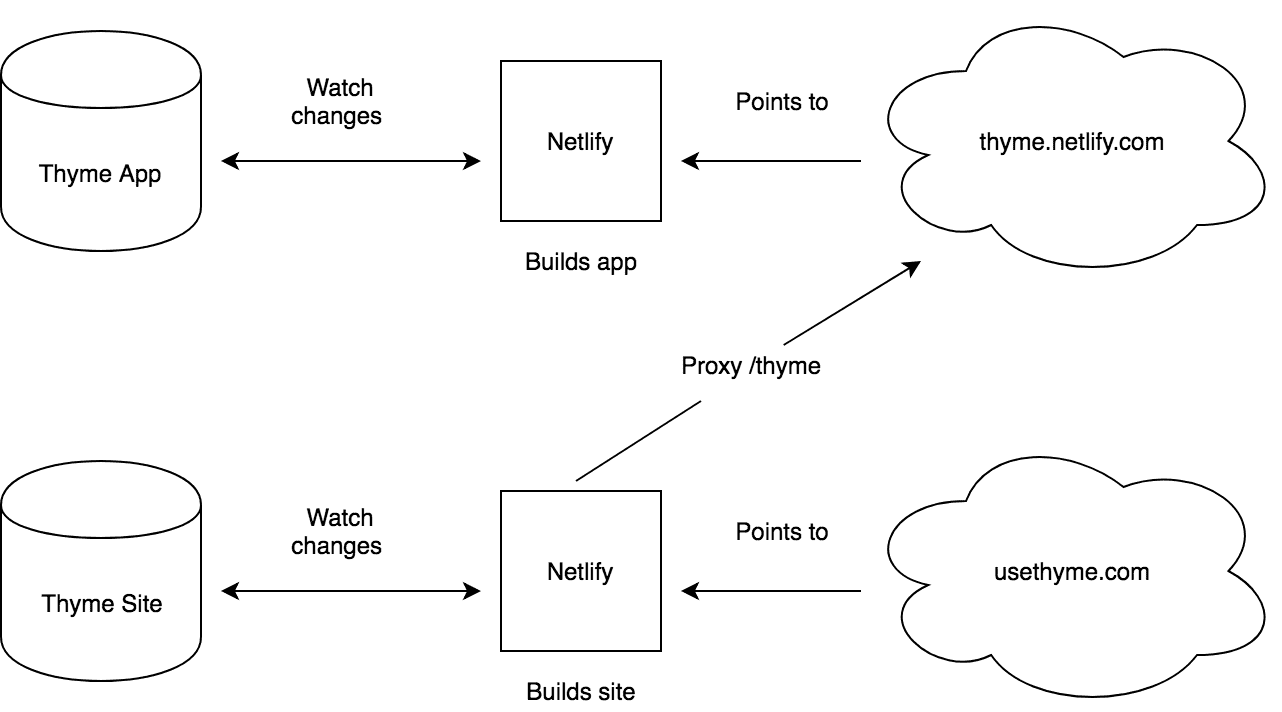Two Sites on One Domain, with Netlify.
Recently I started hosting my open source projects on Netlify because of how easy (and free) it is.
One of the web app projects I made was in need of a website, but I didn’t want to pollute the app’s repository with the website’s source.
I found out that it’s possible to have Netlify show multiple sites on the same domain name. I’ll try to explain what the problem is I was trying to solve and how I solved it.
A note before I begin. Netlify is not sponsoring this article, nor did I ever have contact with them about it. All views and opinions in this article are my own.
The situation
At the beginning of this year I launched a time tracking web application called Thyme. This little web app was hosted on Netlify from the domain name usethyme.com.
Netlify allows you to create a “site” which is based off a git repository. The Thyme application is based on the public repository on Github. Because the application was bootstrapped using create-react-app it was fairly easy for Netlify to recognize how it should build and host the app.
Every time I update the master branch on the Github repository, Netlify will automatically release a new version of the app on usethyme.com.

The problem
After a while I decided that it would be good if the domain name usethyme.com was used as a front-face of the app. A website that details the functionality and has a bit of documentation on the project. The app had to make room for this to happen.
This meant I had to create a website that Netlify can update and publish to usethyme.com. I could add the website’s source to the application repository, but felt like it was best if I keep both projects in a separate repository since I didn’t want people working on the application to get the whole site too.
It also worked the other way around. I didn’t want the website to be in control of the application’s published version or have to update the website with an updated app each time.
Netlify can assign a custom domain name to a site so the built version of the repository is hosted on said domain. A solution to having two sites on a single domain name is using subdomains. Sadly this was not a possibility for Thyme.
Why not just a subdomain for the app?
Since Thyme heavily relies on the usage of localStorage, moving to a different subdomain would mean all the current users would loose their access to data already stored in the usethyme.com storage. If I were to put the application on app.usethyme.com the localStorage data from usethyme.com wouldn’t be accessible for good security reasons.
So what I had to figure out was if it was possible to have two separate Netlify sites, but have the application running in a sub path of the website.
The solution
When digging through the documentation of Netlify I found out you can proxy content through redirects. That’s exactly what I needed! I can have usethyme.com/thyme on my website act as if it is my app.
All I had to change to the app was that it was being served from /thyme/ instead of /. All the routing done in the app and the assets would have to be accessible through usethyme.com/thyme.

The application part
create-react-app and react-router allow you to do this quite easily, but you have to know where to change the source.
In order for react-router to work in a sub path of a domain, you have to pass it a “basename”. In my case, the following change was enough while setting up the “BrowserRouter”:
<BrowserRouter basename={process.env.PUBLIC_URL}>
...
</BrowserRouter>WebPack and WebPack’s dev server provide process.env.PUBLIC_URL while building and serving your project. This will tell react-router what to root of your application is and will act accordingly.
For create-react-app you have to tell the application what its public path is, which they call a “homepage”. In your package.json of the app add a property called “homepage” and add the path where the app will be located.
{
"homepage": "/thyme/"
}If you’re not using create-react-app, you can provide the PUBLIC_URL to webpack through its config to have the same outcome.
The Netlify part
For Netlify I had to make sure my website was being built and hosted correctly. I removed my custom domain from my app’s site and added it to my website’s site in Netlify.
Right now my app was not available on usethyme.com anymore, but it would show my website. My app was now living at https://thyme.netlify.com. Using proxying I had to proxy all traffic to usethyme.com/thyme to https://thyme.netlify.com/.
Using the example I came up with the following content for _redirects (to be placed inside the website’s root folder):
/thyme/* https://thyme.netlify.com/:splat 200And it works perfectly! All my localStorage is still available to the application and my application’s assets are proxied through to usethyme.com/thyme.
A little side note though. Since create-react-app uses service workers I had to put in a little extra proxy line because the browser was not able to find the service worker in the website’s root.
/service-worker.js https://thyme.netlify.com/service-worker.js 200Conclusion
In theory, you can create as many sites as you’d like and make them available on a single domain name using this method.
If you like to keep your repositories clean, this is a great way to do it.
